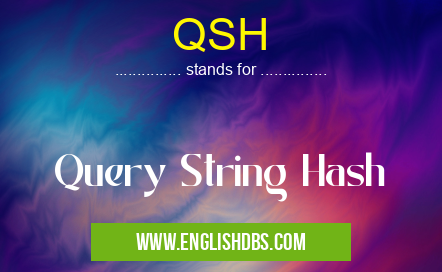What does QSH mean in UNCLASSIFIED
QSH stands for Query String Hash. It is a technique used to secure and protect sensitive data in a URL. By hashing the query string parameters, QSH helps prevent malicious users from tampering with or intercepting sensitive information.

QSH meaning in Unclassified in Miscellaneous
QSH mostly used in an acronym Unclassified in Category Miscellaneous that means Query String Hash
Shorthand: QSH,
Full Form: Query String Hash
For more information of "Query String Hash", see the section below.
How QSH Works
When a web application uses QSH, it generates a hash value from the query string parameters. This hash value is then appended to the URL as a parameter. When the application receives the request, it verifies the hash value to ensure that the query string has not been altered. If the hash value does not match, the request is rejected.
Benefits of QSH
- Protects sensitive data: QSH prevents malicious users from accessing or modifying sensitive information in the query string.
- Prevents URL tampering: QSH makes it difficult for attackers to manipulate the URL to gain unauthorized access to sensitive data.
- Improves security: By adding an extra layer of security, QSH helps protect web applications from vulnerabilities related to query string manipulation.
Essential Questions and Answers on Query String Hash in "MISCELLANEOUS»UNFILED"
What is Query String Hash (QSH)?
Query String Hash (QSH) is a technique used to ensure the integrity of a URL, particularly in the context of a Google Search. It involves generating a hash value based on the parameters in the query string and appending it to the URL. This hash value serves as a checksum, allowing Google to verify that the URL has not been tampered with.
What is the purpose of QSH?
QSH protects against malicious attempts to modify the query string, which could alter the search results or lead to phishing attacks. By validating the hash value, Google can ensure that the URL has not been tampered with and that the search results are accurate and reliable.
How does QSH work?
QSH generates a hash value using a cryptographic algorithm, typically SHA-1 or SHA-256. The algorithm takes into account the parameters and their order in the query string. The resulting hash value is then appended to the URL as a parameter named "qsh." When Google receives the URL, it calculates the hash value again based on the parameters and compares it to the provided QSH. If the values match, Google trusts that the URL has not been modified.
Is QSH mandatory for all URLs?
No, QSH is not mandatory for all URLs. However, Google recommends using QSH for URLs that include parameters in the query string, especially for sensitive or critical operations. By implementing QSH, website owners can enhance the security and integrity of their URLs.
How can I implement QSH on my website?
Implementing QSH on your website involves generating the hash value using a supported cryptographic algorithm and appending it to the URL as the "qsh" parameter. The specific implementation method may vary depending on the programming language and framework you are using. Consult the documentation or resources provided by your chosen technology for more detailed instructions.
Final Words: QSH is a valuable technique for securing sensitive data in URLs. It helps prevent malicious users from tampering with or intercepting sensitive information, improving the overall security of web applications. By implementing QSH, organizations can protect their data from unauthorized access and ensure the integrity of their web applications.
